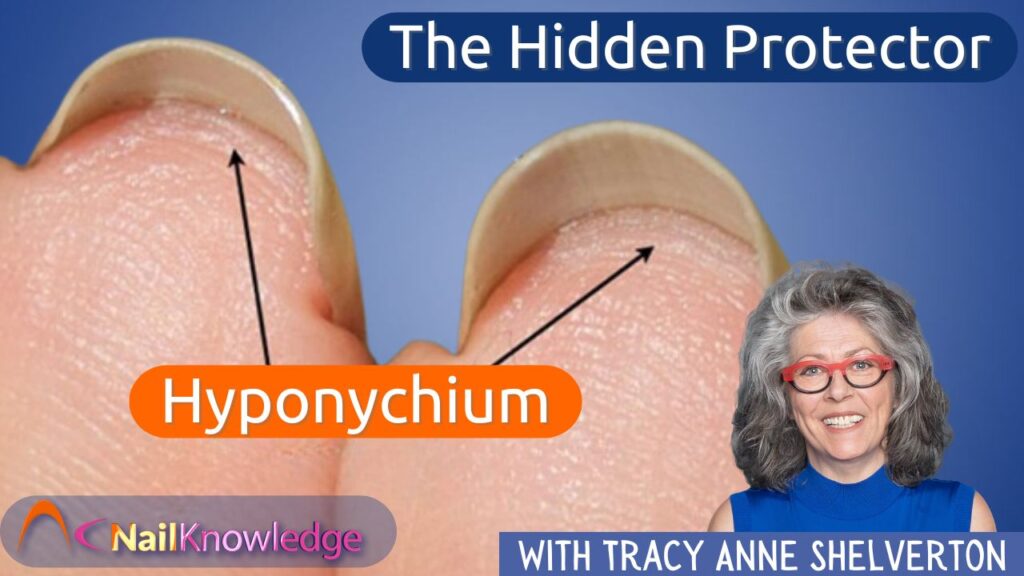El protector oculto
Como profesional de las uñas, sabes lo importante que es mantener unas uñas impecables, pero ¿cuántas veces hablamos realmente de la hiponiquio? It might not be the most glamorous part of the nail, but it’s one of the most crucial. If you’ve been overlooking it, now’s the time to change that. Let’s investigate why the hyponychium deserves your attention and how understanding it can elevate your nail care skills to a whole new level.
¿Qué es exactamente el hiponiquio?
The hyponychium is the area of skin right under the free edge of the nail plate—the part of the nail that extends past the fingertip. Think of it as the gatekeeper of the nail unit, forming a seal that keeps harmful bacteria, pathogens, and allergens out. It might look small and simple, but it plays a big role in keeping the sensitive areas of the nail bed and matrix protected. Neglecting this area could leave your clients vulnerable to infections or other nail issues, which brings us to our next point.
¿Por qué los técnicos de uñas deben preocuparse por el hiponiquio?
As nail professionals, your clients rely on you to not only make their nails look great but also to keep them healthy. The hyponychium is packed with nerve endings—sort of like a security system for the nail. If this protective seal is broken, those nerve endings kick into gear, alerting the body with discomfort or pain. This should be your first clue that something isn’t right. A compromised hyponychium can open the door for bacteria, fungal infections, and even onycholysis (when the nail plate starts separating from the nail bed).
En resumen: un hiponiquio sano significa unas uñas felices y sanas. Y eso significa clientes contentos.
Signos de que el hiponiquio necesita atención
Como técnico de uñas, conocer los signos del hiponiquio puede evitar problemas mayores. He aquí algunas cosas que debes tener en cuenta:
- Engrosamiento o decoloración: Si el hiponiquio empieza a espesarse o a cambiar de color, podría ser un signo de infección. Si se sospecha de una infección fúngica, haz una prueba para saberlo con seguridad y trata en consecuencia.
- Dolor o malestar: Your client mentions sensitivity or pain around the free edge—this could indicate that the seal has been compromised.
- Onicólisis: If you notice the nail lifting from the nail bed, that’s a major red flag. This condition often stems from a damaged hyponychium and can lead to a more serious infection if not addressed.
El impacto del hiponiquio en la salud de las uñas
If the hyponychium is compromised, it doesn’t just affect the appearance of the nails—it can cause real health concerns for your client. Infections can develop, and untreated issues can even lead to long-term damage to the nail matrix. You don’t want that for your clients, and they don’t want to deal with it either.
¿Cómo proteger esta zona tan importante? La clave es manipular las uñas con cuidado. Limar demasiado el borde libre o utilizar herramientas demasiado agresivas puede dañar el hiponiquio. Además, asegúrate de animar a tus clientes a evitar malos hábitos como arrancarse las uñas, que pueden romper el sello e invitar a la infección.
Una buena higiene de las uñas es su mejor defensa.
Here’s what you can do as a nail professional to maintain a strong and healthy hyponychium for your clients:
- Archivado suave: Al dar forma a las uñas, evite el exceso de limado cerca del borde libre para proteger el hiponiquio.
- Limpio pero cuidadoso: Mantenga limpia la zona de la uña, pero evite pinchar o empujar demasiado fuerte el hiponiquio.
- Atención a los signos de infección: Esté siempre atento a la decoloración, engrosamiento o signos de incomodidad.
- Educar a los clientes: Enseñe a sus clientes la importancia del hiponiquio y las rutinas adecuadas de cuidado de las uñas para mantener esta zona intacta.
- Mantenimiento de la unidad de clavos: When applying oil, do so at the back side of the free edge, this way the oil first soaks around the hyponychium before it makes its way along the lateral nail folds to the PNF.
Final Thoughts: Don’t Overlook the Hyponychium
As a nail professional, your expertise goes beyond just aesthetics—your job is to protect the health of your clients’ nails. The hyponychium may be hidden, but it plays a critical role in nail health. By giving this small but mighty structure the attention it deserves, you’re ensuring your clients not only walk away with beautiful nails but with nails that are strong and healthy from the inside out.
So, next time you’re prepping a client’s nails, take a moment to think about the hyponychium.
It’s not just another part of the nail—it’s the silent protector that makes all the difference.


